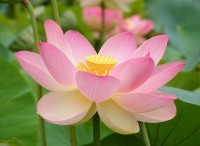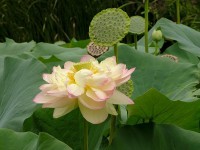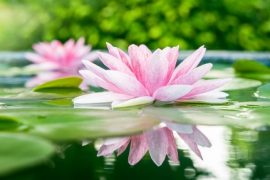YOGA AND HINDUISM: THE LOTUS FLOWER
In Hinduism, the lotus flower symbolizes purity. In many ancient cultures, the lotus has always been considered a divine flower, including in ancient Egyptian civilization. In Hinduism and Buddhism, the lotus symbolizes the true nature of man.
It is a beautiful flower that grows from polluted or turbid water to the light, untainted, with no mud (the symbol of ignorance) on the petals, nor water. Many gods in Hinduism are therefore associated with the lotus flower. They hold one in their hand or are adorned with it.
In yoga the sahasrara chakra, at the top of the crown, is called the yarrow lotus. It is the chakra of the samadhi, the redemption, represented by the lotus flower with a thousand leaves that contains all the nuances of all colors.
The sacred lotus or Indian lotus
Hindu lotus flower. The Indian lotus is a water lily ( Nelumbo nucifera ). A flower with round or oval leaves. The plant can reach almost 6 meters, which depends on the depth of the mainly swampy waters in which it grows. The Indian lotus blooms throughout the year. Mud splashes do not stick, the beautiful petals remain just as beautiful in the muddy pool. This is called the lotus effect and is partly the reason why this flower is of great symbolic significance in religious and spiritual thinking in both Hinduism and Buddhism .

Indian lotus flower ( Nelumbo nucifera ) / Source: Peripitus , Wikimedia Commons ( GFDL )
Distribution
The Indian lotus ( Nelumbo nucifera ) grows in many countries and regions, although it is called Indian or sacred lotus . Of course it is common in India, but also in the Indonesian archipelago, Korea, Japan and even in the United States, South America and Australia.
The lotus flower a mythical plant
In the rich Hindu mythology about creation in all its facets, the world or the earth floats like a lotus flower on the water. The fruit bud in the center of the flower represents the sacred mountain of Meru. The four petals in the lotus crown symbolize the four main continents. Contaminated by water, pollution and mud, the lotus stands for beauty, purity and, by extension, holiness.
Lotus flower meaning yoga
The lotus symbolizes the yogi who is detached from all sense delusions, or the externalities and temptations of earthly existence. Appearances that distract man from his true nature. Just as the lotus flower seems detached from the environment in which it grows, so does the enlightened person stand in the world or society.
He is inwardly not bad, not sullied or sucked. After all, the yogi is aware of the fact that prosperity and adversity are part of the great order that is inherently contained in karmic settlement, reincarnation and thus ultimately in justice. Thanks to this indestructible symbolism in Eastern thinking, many Hindu gods are depicted with a lotus flower. Like Brahma, the creator, sitting on a lotus. And Vishnu, the sustainer of creation, lying on a lotus flower.
Buddhism
The lotus has a similar meaning in Buddhism. The plant symbolizes the true nature of man, the true nature (the Self) which, unlike the ego and without being aware of it, remains clean and radiant amid ignorance ( avidya ) and the perils caused by the karmic sequences ( reincarnation ) of earthly existence, or the cycle of birth and death ( samskara ). Almost all Buddhas are depicted meditating on a lotus flower.

Indian lotus flower ( Nelumbo nucifera ) / Source: Photo by and (c) 2007 Derek Ramsey (Ram-Man) , Wikimedia Commons ( CC BY-SA-2.5 )
The holy mountain Meru
Mount Meru plays an important role in Hindu mythology in the story that everything is created from a milk ocean. Mount Meru stood in the middle of that ocean. The serpent of eternity wriggled around the mountain and then churned the milk ocean with its tail.
This “stick” with which the milk ocean was churned, giving shape to the universe, is called merudanda and in yoga it symbolizes the backbone through which the life energy , or the kundalini, flows. This life energy illuminates, activates and stimulates the seven chakras one by one and from bottom to top. Eventually, the kundalini also arrives at the sahasrara chakra, at the crown of the head, represented by the yarrow lotus flower.
Sushumna
The Hindu theory of the chakras, of which every person is said to have seven (classical concept), shows how the lotus flower is interwoven with yoga. The Sanskrit word chakra means ‘wheel’, ‘rad’ or ‘circle’, but also padma (lotus flower) from which the yoga posture padmasana (lotus position) is derived.
The chakras or padmas are located along the shushumma, a tubular opening in the middle of the spinal cord. As man develops spiritually, the kundalini (snake power) flows further and further up.
Nerve centers
As the chakras open along the spine, man becomes more sensitive to other people (empathy) and he would acquire supernatural abilities, such as telepathy and clairvoyance. The chakras are often mentioned in the same breath with nerve centers or nerve nodes . The chakras are arranged vertically along the spine, or the world axis (merudanda) in Hindu mythology.
The seven chakras and the lotus flower
According to yoga philosophy, each chakra performs psychosomatic functions with the help of the ascending kundalini that “animates” or activates the chakras. They symbolize the sevenfold composition of man, so aptly expressed in Egyptian mythology :
” The veil of Isis sevenfold
will be like a haze for him,
through which he
will see the Ancient Mystery with a clear eye .”
(Quote from: ‘Introduction to the chakras’, Peter Rendel, Aquarian Press, Wellingborough)
Muladhara chakra
This chakra is located at the bottom of the backbone. The root center is visualized with four lotus leaves. Curled up like a snake, the kundalini is resting there. The chakra has the element of earth, the sense of sense of smell, and symbolizes the contented, grounded human being, attached to his birth ground and with a strong appetite for the material. Solidity, or solidity, is the core value of this chakra, also called the basic center.
Svadhishthana chakra
The chakra is located at the height of the sacrum and has six orange-red lotus leaves, also known as the “home town” and seat of sexual urges. The swadhisthana chakra symbolizes the Hindu god Vishnu , source of love and wisdom. The element is water that always wants to flow down and therefore contract, connected to the ‘fluid’ functions of the physiological system, such as the kidneys . This chakra has the taste as a sense.
Manipura chakra
This “nerve center” is located at the level of the navel and is usually called “solar plexus” (solar plexus). This chakra, the “jewel city”, is golden with ten lotus leaves for visualization. The solar center symbolizes expansion and has fire as an element. It is an element that wants to expand, that wants to digest. When the manipura chakra opens, intuition will develop strongly, peace will come to oneself and the environment. It symbolizes the ‘middle’ of man, hara in Japanese, also connected to the two lower chakras. This padma has the eyesight as a sense.
Anahata chakra
The heart center is located at the backbone at the height of the breastbone, at the heart , the supposed seat of emotions. This chakra is visualized with twelve golden lotus leaves, symbolizes the element of air and has the sense of touch the sense of touch. The core values are mobility, moving and making contact with connectedness and sympathy.
Vishuddha chakra
The chakra symbolizes purity, purity. The larynx center is located at the back of the throat and is visualized with sixteen lotus leaves. The element is ether, the ‘space’ in which the previous four elements are active. The vishuddha chakra forms the bridge between the mind (brain), or the ajna chakra, and the four lower chakras symbolized by the four elements mentioned. The vishuddha chakra has the voice as a sense organ.
Ajna chakra
The forehead center is located between the eyebrows, in the middle of the forehead, also called the Third Eye, visualized with two lotus leaves. This padma is said to be the center of the life force, the gateway of cosmic consciousness and intuitive knowledge. The ajna-chakra also symbolizes the mind ; the Sanskrit word ajna means “policy” or “direction.” It refers to the control of the personality, or the efficacy of the mind.
Sahasrara chakra
The crown center is located at the level of the pineal gland, also known as the yarrow lotus. The visualized yarrow contains all color nuances and is the seat of Shiva, seat of samadhi (liberation, satori in zen ). The chakra is often depicted with images of sacred persons with a halo around their heads, such as with Buddha and Jesus images.
Also the tonsure of Christian monks finds its origin in the efficacy of the cross center. The sahasrara chakra symbolizes the union of the lower self with the higher self, or the true meaning of the concept of yoga. In Christian terms it means “Mystical Marriage”, in Hinduism the fusion or unification of spirit and matter.
The activation of the sahasrara chakra is accompanied by a clear and profound spiritual insight and an indescribable calm of mind. Or the realization of tat tvam asi (that is me and that is me); the sense of unity with ‘creation’, where the realization dawns that the environment is a mirror image of what is going on inside
Kundalini
In yoga philosophy, kundalini is the life force that is rolled up like a snake in the muladhara chakra. One of the most important principles of orthodox hatha yoga is to activate and activate this snake power through yoga postures (asanas), breathing exercises (pranayama) and meditation.
Thus, as evidenced by, among other things, the esculatory snake, the kundalini force rises in the sushumna and pushes this energy through all the chakras along the backbone, from the swadhisthana chakra to the sahasrara chakra. Yogis and mystics Entering kundalini into the sahasrara chakra, symbolized by the yarrow lotus flower
, the individual consciousness merges with the cosmic consciousness, or the reunification of the individualized cosmic force with the transcendent primal source. According to many yogis and Christian mystics, this is accompanied by an overwhelming sense of peace and compassion towards everything created.

